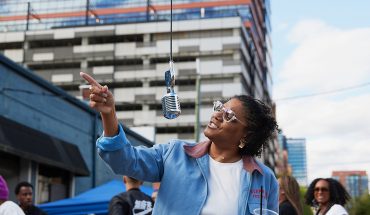by Liza Roberts
photographs by Jillian Clark
A burst of creative energy shook up professor Justin LeBlanc’s class at N.C. State School of Design one recent morning: New York designer Zang Toi stopped by.
A whirl of beaming smiles, charming anecdotes, inspiration, and hard-won insight, Toi gave a master class to the group of aspiring textile and fiber designers before heading up to meet his stable of loyal Triangle clients at Saks Fifth Avenue.
A morning with students was right up his alley. “It’s my duty as an elder statesman,” said the diminutive 55-year-old designer, dressed as he often is in his own logo-emblazoned mini kilt, black brogues, layered T-shirts, and diamond barrette
(a look immortalized by the late New York Times fashion photographer Bill Cunningham). “It’s important that I give back,” Toi said.
He met with several students individually to critique their designs, gave them all a peek at his latest collection, and shared his story. It’s a quintessential tale of American immigrant success that begins humbly in a small Malaysian village where Toi was the youngest of seven children; continues with his arrival in New York with only a few hundred dollars in his pocket; builds with his sleepless years as a student at Parsons School of Design by day / fashion designer apprentice by night; and culminates with the opening of his own atelier, his recognition by Vogue magazine, and his current, globe-trotting success.
Toi’s designs are refined, feminine, and elegant, reflecting his imperative to create “timeless beauty.” He has the freedom to make the clothes he believes in and to give back to students like State’s because, unlike many other American fashion designers, he’s his own boss, independent of a corporate parent. That affords him the freedom to stop and teach, if that’s what he wants to do, and to work the way he likes to work. That means spending a good deal of time on the road all over the country, meeting the women who wear his clothes, learning their needs, and customizing his designs. “You cater to the ladies who adore your clothes,” he says. “You serve them: ‘Zang, can you make this in a 22?’ No problem.”
“I tell him he’s the only modern-day couturier,” said Patricia Tollinger, designer manager at Saks. “If you want a sleeve, if you want a different color … he’ll send the client a muslin, they send it back to New York, and we get a custom cut.” After 28 years in business and three visits to the Triangle, Toi’s following here is growing, Trollinger said. And the relationships last. For Toi, that’s a big part of what he loves about his work.
“I love the Southern ladies,” he said. “They’re very feminine, they love to dress up, they love pretty clothes, and they don’t necessarily need to follow the trend of the moment.” Toi said knowing his clients informs everything he does. “It’s a learning curve, for an American designer: It’s such a vast country. When you meet your clients, you learn what their needs are.”
Answering actual needs in a practical manner is something he believes students of fashion should be willing and excited to do. “It’s great to be creative and come up with the most fabulous runway show,” he said, “but at the end of the day, it’s a business. You have to meet the needs of real people. You want a piece that gets a standing ovation, but you also need the meat and potatoes.”
The Spring 2017 collection he showed the students did not call to mind meat or potatoes. It conjured springtime, ballrooms, twinkling music. Inspired by a recent trip to Paris and by Monet’s gardens at Giverny, his dresses dripped with lavender wisteria; his trench coats were a chic homage to his “fashion hero,” the late Yves Saint Laurent. When it debuted,Women’s Wear Daily called Toi’s collection “first class.”
LeBlanc and his students agreed. “Zang is a wonderful example of what it takes to be successful,” LeBlanc said. “I loved the fact that he said that in school, he always had to work three times harder to really capture his vision.”
LeBlanc’s students, many hard at work on their own creations for the school’s biggest annual fashion event, Art2Wear, already have a firsthand idea of how much work goes into a successful collection. Toi said he was impressed with what he saw.
“Beautiful, beautiful seaming,” he told Laura Wyker, a senior whose Art2Wear collection is made entirely of leather. “Have you fit it on a girl yet?” She had. “Tell me about your collection,” he said to senior Lizzy Lawrence, examining her clothing’s seams and zippers, and picking up a woven sphere on her table. “Is that a hat?” No, she told him, “that’s a sleeve.” Pointing to a sheer overdress she’d made to cocoon a woven sheath (above), he smiled: “This,” he said, “This is cool.”











